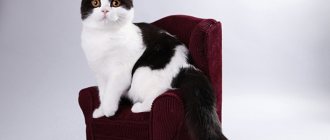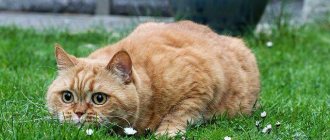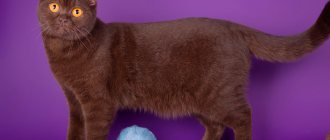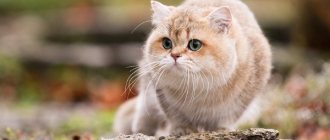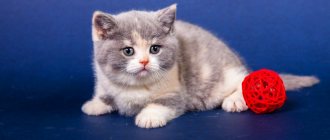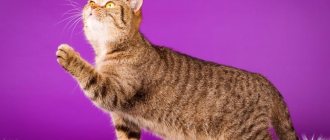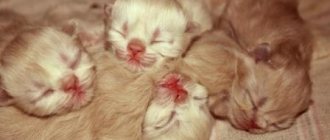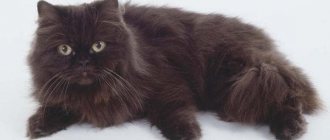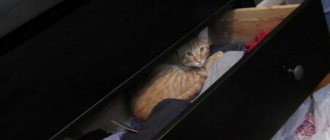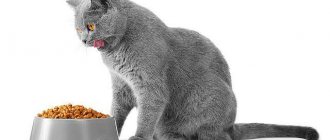WHITE BRITISH: COLOR STANDARD
The color of white British cats should be even, clean, uniform, each hair should be equally colored from top to bottom.
A white British cat should not have spots, stripes, or “smoky” dark hairs. There should also be no yellowness; it is most often found near the eyes, at the base of the tail and on the head. The nose and paw pads of a white British breed should be pink.
Important! In childhood, white kittens often have small spots (on the head), which indicates the absence of deafness. As the years progress, all these spots disappear.
The white British cat has an interesting feature: the fact is that the hairs are not white, and the color of the coat is hidden by the W gene.
Eye color in white cats can be in three variations:
- orange (BRI w 64)
- blue (BRI w 61)
- odd-eyed (BRI w 63)
GENETICS OF WHITE COLOR
The genetics of this color are one of the most interesting. The “W” gene is responsible for the white color, which seems to “hide” any other color under the white. In other words, under the white color there can be any other color that is “covered” with white paint.
And it’s not even entirely correct to call animals of a given color colored at all. After all, there is no pigment in their fur at all; more precisely, they are not colored.
White cats have the “W” gene - dominant. Genotype "WW" or "Ww". Cats with the “WW” genotype will produce offspring of only white color (regardless of what color the second sire is), and cats with the “Ww” genotype can produce offspring of both white and other colors.
The first sign of a white color is a pink nose and no rim, which is extremely important, because... many may confuse this color with the silver chinchilla.
Let's take a closer look.
W – white epistasis, covers all colors (dominant gene).
w – allows color to appear
The “W” gene also affects the hearing organs and eye color. Often white animals with blue eyes suffer from deafness.
Eye color in white cats depends on the “c” and “ca” genes.
“c” is a true albino, pink iris, “sa” is an albino with blue eyes.
INTERESTING TO KNOW
- White cats with blue eyes will most often be deaf, since this color is linked to hearing genes.
- Cats with different eye colors (one eye is blue, the other is golden) can be deaf in one ear - exactly on the side where the eye color is blue.
- This color, unfortunately, carries many mutations and often cats of this elegant color cannot boast of such excellent health as their colored counterparts, and their immune system is also weaker.
- Two white cats can produce a kitten of a different color (if the genetic formula of the parents looks like Ww+Ww)
- two non-white parents can never produce a white kitten (since the gene for white color - W - is dominant)
Character
When you look at a white British man, you have an uncontrollable desire to cuddle him. However, the animal itself does not tolerate familiarity. Although kittens do not refuse to play and caress with their owner. Adults do not like to be held. If you pet a British cat while sleeping or when she is busy doing something, the animal will most likely leave or show sharp claws. The owner can only resign himself and caress the pet with his eyes.
Owners of white British cats often admit that they do not feel like their owners. This does not mean that animals do not need care and love. They crave attention just like other cat breeds, but they do it in their own way. A curious pet can follow a person on his heels, carefully watching what the owner is doing.
The white British cat is inherently respectable; she will rarely rush around the apartment or jump on the closet. Having accustomed the pet to the scratching post in a timely manner, the owner does not have to worry about the safety of the furniture. These cats are not annoying or mischievous. In general, British cats have an easy-going character. To prevent your pet from turning into a sofa cushion, you need to monitor its weight.
The British meow on rare occasions. As for heat or severe stress (visit to the clinic, traveling by car), some owners do not hear their cat for months. Begging for food is beneath the dignity of white British people. The most the cat will do is cast a reproachful glance towards the owner.
You should not buy a British cat for families with small children. A rare representative of this breed favors children. Children are too clingy and noisy, which can turn a cat’s life into constant stress and the search for a secluded place to sleep. The British do not like long games and persistent petting. It will be difficult to explain to children that this plush miracle is inviolable.
WHITE BRITISH CATS: PHOTOS OF ADULTS
Below is a gallery of photos of British cats and cats.
Appearance and description of the British
A distinctive feature of the British is their spectacular appearance. The breed is characterized by a well-developed body and head. The cat's head is round, its cheeks are pronounced, and it is wide around the cheekbones. Kittens have a squat, large body. Muscular torso. The British can boast of an aristocratic posture: a wide back, massive shoulders, and a short neck. The cat has large paws and muscular legs. The tail is fluffy, of medium length, with a rounded tassel on the tail. Kittens' ears are small and rounded. Some varieties have British Fold kittens. White cats are usually large in size, with wide-set eyes. You can find blue-eyed fluffies, sometimes with honey eyes.
Particular attention should be paid to wool. The cover is quite dense, with a thick undercoat. The awn is dense and short.
The weight of an adult cat does not reach 5 kilograms. As for males, they can gain up to 7 kg.
WHITE BRITISH KITTENS: PHOTOS OF SMALL KITTENS
We are pleased to present photos of white British kittens.
| In our cattery you can “buy a real British kitten.” We have many different colors, we will help you choose and answer all your questions! |
History of the origin of the breed
First option
According to historians, the Briton is one of the most ancient breeds. Surely, many remember that cats were especially popular in the Roman Empire for hundreds of years. Emperors, as a rule, had not one or three cats, but about a dozen pets. These cats were brought to Britain by Roman soldiers from Ancient Rome . The images that have been preserved from those times show that they were short-haired gray British dogs not only with large round eyes, but also quite sharp fangs.
Second option
Absolutely opposite to the first version is the second version of the origin of British seals. According to the second story, these wonderful animals appeared on the British Isles thanks to French sailors, who took them with them on voyages in the hope that the cats would protect their ship from rats and mice. In France they were also used as rat catchers in wine cellars.
Health issues
Since the British Folds were the result of interbreeding, the likelihood of genetic diseases among representatives of this feline species is very high.
British Folds are susceptible to genetic skeletal diseases
Thus, with age, osteochondrodysplasia may appear, expressed in lameness and deformation of skeletal bones (paws, vertebrae). This disease is incurable, so it is important to visit the veterinarian regularly if the kitten’s parents were two lop-eared individuals. If one of the parents had straight ears, the likelihood of pathology is significantly reduced.
In addition, British Fold cats are susceptible to typical diseases of all purring cats:
- viral infections (cat cold) - goes away on its own within two to three days, otherwise you should see a doctor;
- hypertrophic cardiomyopathy (heart pathology) - treatment is long-term (lifelong) and is supportive;
- polycystic kidney disease is an incurable disease; with maintenance therapy, cysts stop growing;
- claw fungus - can be cured with special antiseptic and antifungal solutions;
- infestation with parasites (worms, fleas) - preventive measures for deworming and getting rid of ectoparasites should be mandatory for representatives of the breed.
To maintain the health of your teddy pet, you must regularly visit the veterinary clinic for vaccinations. Vaccination begins at the age of 2.5 months and then every 3-6 weeks until the kitten is 15 weeks old.
This is followed by comprehensive annual vaccination against respiratory tract infections, panleukopenia, ringworm and rabies.
If you follow the rules for caring for your pet and carefully monitor the health of the British Fold, the animal will live up to 12–15 years.
Feeding the cat
British cats are not picky eaters. Therefore, when compiling their menu, you can rely on general principles applicable to representatives of other breeds.
You can find out more about feeding your pet in the article “What to feed British cats.”
Complete diet
When feeding natural products, the British Shorthair's menu is designed so that lean types of meat predominate. Also, the cat must be given:
- boiled vegetables;
- porridge with water;
- eggs;
- dairy products;
- sea fish.
It is strictly forbidden to feed your British cat sweets, baked goods, river fish, pork, sausages and whole milk. Smoked, salty, spicy and fried food, as well as any goodies from the master's table, are forever excluded from the menu of the breed.
When dry-feeding a British Shorthair, select premium, super-premium or holistic class products that do not contain questionable ingredients. Cats of this breed eat Hills, ProPlan, 1stChoice and RoyalCanin well. The daily portion for a Briton is calculated according to the table on the packaging.
Important. The British Shorthair cat should have easy access to a bowl of clean drinking water.
Feeding frequency
British kittens eat less, but more often than adult representatives of the breed. Therefore, when drawing up a regimen, be sure to take into account the age of the pet:
- up to 2 months – 5-6 times a day;
- 2-5 months – 4 times a day;
- 5-12 months – 3 times a day.
A one-year-old British cat is switched to twice feeding.
Vitamins and minerals
The body of a Briton who eats natural foods periodically experiences a deficiency of microelements. To compensate for this deficiency, the cat is given special supplements twice a year to strengthen the immune system, joints and improve the condition of the coat.
To select a vitamin-mineral complex, you need to contact a veterinarian, who will recommend a suitable drug.
Most often, British cats are prescribed:
- 8 in 1 ExcelBrewer'sYeast;
- Ani Vital FeliDerm;
- Beaphar Laveta Super.
On a note. British Shorthair cats that eat high-quality dry food do not need additional vitamins.
